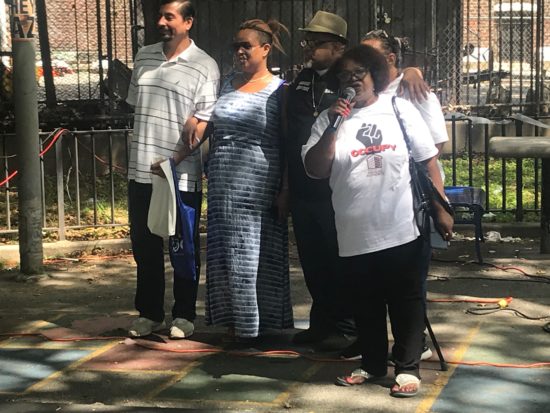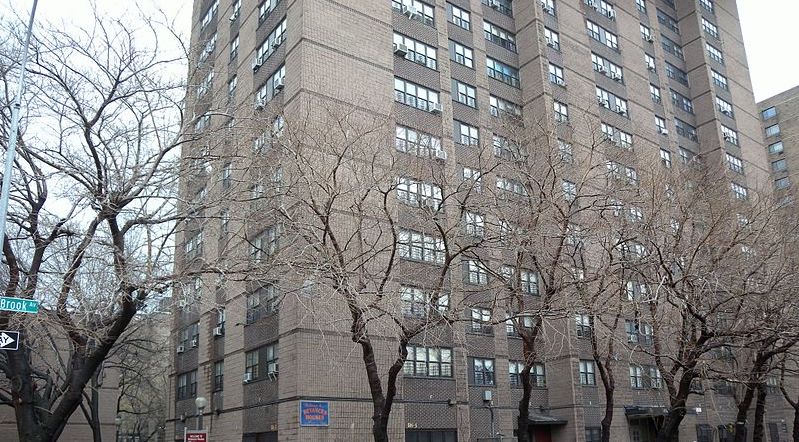
Mayor’s pick to head public housing will push for privatization, they argue
NYCHA residents in the South Bronx worry that a sweeping new public-private partnership under consideration in the City Council would accomplish what many have long feared: displace them from their homes. They argue that Mayor Bill de Blasio’s pick to run public housing has a track record of kicking poor people out of their homes in other major cities, and suspect that that is what his new hire has been contracted to do in New York City.
De Blasio announced in July that Gregory Russ will run the embattled Housing Authority. Russ is a proponent of Rental Assistance Demonstration (RAD), a federal initiative that leaves the day-to-day management and repairs for public housing in the hands of private developers, even while those buildings remain under the Housing Authority’s state guidelines. Housing advocates suspect that it’s a Trojan Horse to allow developers to get their foot in the door before full scale privatization of public housing.
At a July 26 Occupy NYCHA rally on the steps of City Hall, tenant leaders criticized the mayor’s new hire, and his eagerness to pilot RAD in the city.
“I am no one’s guinea pig,” said Claudia Perez, tenant president at George Washington Carver Houses in Harlem.
Russ, who converted Minneapolis’ public housing stock to RAD during his time as that city’s public housing czar, has said he will enroll a third of NYCHA’s 186,000 public housing units to the program.
But while RAD is touted as a way to secure much of the estimated $32 billion needed for repairs and upgrades for NYCHA, many tenants are skeptical.
Before the rally, Ruth Mackins, a resident of the Polo Grounds Housing Project in Harlem, pulled up a photo of her bathtub, filled with brown water. She says she has had to flush a tubs’ worth of dirty water out of her faucet every day for the last 10 years. But instead of sending plumbers to fix the problem, the management office at Mackins’ building sends low-skilled maintenance workers to snake out her drain until the inevitable next clog. She wants the city to fix her apartment without resorting to the new program. (NYCHA regulations forbid tenants from hiring outside contractors to conduct repairs.)
The city claims that problems like those Mackins is contending with are the whole point of RAD.
“This is not privatization,” de Blasio said at a Nov. 2018 press conference at Betances Community Center in Mott Haven. “This is a way to get private dollars in to help us achieve the public good.”
De Blasio’s appearance at Betances came as he announced that that sprawling NYCHA complex was being converted to RAD. Around the same time, the city signed a 99-year lease with Bronx-based Wavecrest Management to manage day-to-day operations for Betances’ 40 buildings between 136th and 145th Streets.
Local blowback ensued. Wavecrest, which manages Bronx units for 15,000 tenants, has come under fire in recent years for neglecting repairs in its buildings and ignoring complaints. But the company has secured a $120 million grant to renovate the bathrooms, roofing, painting, kitchens, and floors in Betances’ 1,088 units over the next two years, and has since begun repainting hallways and cleaning floors.
South Bronx tenant leaders say the city never consulted with local tenant leaders before awarding the contract to Wavecrest.
“We can actually tell you how to fix this thing, if they’d just listen,” said Ronald Topping, tenant association president for John Adams Houses. The city’s plan to switch a third of NYCHA citywide from Section 9 public housing to a Section 8 voucher system under RAD will make it harder for him and the thousands of tenants he represents to be heard, said Topping. NYCHA’s democratically-elected resident councils are authorized to advise NYCHA on key issues, such as selecting contractors and designing their contracts with NYCHA. Once NYCHA buildings are no longer enrolled in Section 9, those tenant councils will lose their legal authority, causing tenants to lose their seat at the table.
Responding to the criticism of its track record in an email, a spokeswoman for RDC, the company working with Wavecrest to combat Betances’ mold and lead problems, said that RDC has ordered testing to confirm the extent of lead in NYCHA buildings, and has plans in place “to determine how much remediation is needed.”
“All areas tested in the apartments are now confirmed to be lead-free, therefore, no lead remediation needs to be performed,” the spokeswoman wrote, adding that “Of the 3,000 XRF tests in the hallways, common areas, and exterior of the buildings, 26 of the 39 residential buildings were confirmed to be lead-free in the hallways, common areas, and exterior. Therefore, no lead remediation needs to be performed in 26 of the buildings.”
But NYCHA leaders say that the structural issues that plague their buildings and jeopardize their health are still not being addressed.
“The mold in The Bronx has reached eight times the national average, and we’re talking about repairing our kitchens and bathrooms,” said Manny Martínez, tenant resident at Queens’ South Jamaica Houses during the July rally. He noted that NYCHA’s extensive lead exposure problem, which has been called ‘The New Flint,’ is more than any one management company can handle. Martínez says that the mayor is “trying to take away our equity. This has to do with the federal government on down that’s trying to take over our land.”
Russ’s critics add that he has conflicts of interest that should force de Blasio to replace him. While conducting the RAD changeover in Minneapolis, Russ’s father-in-law Ken Talle has served as owner and president of Thies & Talle Inc., one of Minnesota’s biggest property management companies, which specializes in Section 8 housing. Russ’ wife is a vice president at that firm. Additionally, critics say Russ hired an ex-NYCHA employee after she was charged by the New York City’s Conflict of Interest Board for advising a company seeking a RAD contract on an NYCHA project while she was still employed by the authority.
As Occupy NYCHA’s City Hall rally was playing out at City Hall, Comptroller Scott Stringer was giving a press conference just over the Brooklyn Bridge at NYCHA’s Ingersoll Houses. Stringer was announcing the findings of an audit his office had conducted, which found that NYCHA had wasted millions on roof repairs that should have been were still under warranty.
“At a time when every penny counts, NYCHA is essentially lighting every penny on fire by investing millions in roof repairs when it doesn’t have to,” Stringer said at the press conference, according to The Brooklyn Eagle.
The comptroller’s office also found that roughly half of the 35 roofs NYCHA inspected citywide had significant to moderate deficiencies like ponding water, soft/spongy spots, and blisters and cracks, costing taxpayers an additional $24 million in repairs.
At a Family Day event at Adams Houses on Aug. 10, Adams’ tenant leader Ronald Topping was joined by other NYCHA organizers from around the city to keep the pressure on the mayor.
“They’re coming for your homes, man,” shouted Carmen Quinones, a tenant leader from an East Harlem NYCHA complex. “We can’t go anywhere else.”
Additional reporting contributed by Joe Hirsch.

